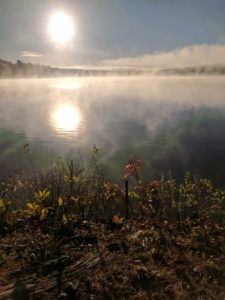 |
| (photo: Gina Marie) |
Yoga Sutra II.44
There never seems to be a lack of opportunity to be introspective, that is for sure. I am not assuming that you have all the time in the world to sit around and go deep into the layers of your being. What I am suggesting is that there are numerous opportunities that present themselves in our lives that can be a perfect time for introspection, our study. All too well, I know this from my own life. My reactions and actions speak for themselves. When I get a pit in my stomach from the way that I may have spoken to a loved one or the way that my left upper shoulder area aches when I take on too much, each signal to me how out of alignment I am with my self and my Self.
So what is the smaller self and what is the bigger Self? At the time of our birth (wherever in the process you believe that is), we form our personality, the one that presents itself to others. Prior to that we are part of this Universal Consciousness, connected to nature and creation. We don’t disregard our smaller self but look within for areas that we can develop in our humanessence. We can study the universal nature, through reading sacred texts. Reflection on both aspects, inspires an integration of the two.
We are curious beasts and may approach our understanding of ourselves in two ways with yoga. A dear colleague of mine, Jennie Lee, wrote in her book, True Yoga, “…there are two directions we can take to study the Self. Practice of right posture (Asana) is the vehicle that many Western practitioners are attracted to initially to journey from outside in, through the development of the body and its subtle expressions of the Soul. They are often surprised by the inner transformation that awakened as a result of physical rebalancing. Others are compelled to understand yogic philosophy first and then find their way to the value of physical practices that support the inner journey. Either way requires time, focus, and energy, and eventually both ways brings us within. “
This Sutra placed alongside our restorative practice can bring us to reflect upon many of these inroads to integration – studying our small self, the Universal Self, or approaching the study through physical asana or reading the sacred texts of Yoga. Restorative poses are the perfect time to reflect.
Jennie shares a few nuggets that can be part of your daily practice for Self-study. I highly recommend her book, True Yoga, as an easy to understand and practical guide to the Yoga Sutras. She is also the author of a new book, Breathing Love: Meditation in Action, due out on January 8, 2018.
Connect with her on https://jennieleeyogatherapy.com.
Daily Practice (from True Yoga)
- Carve out quiet time everyday . Commute to work or school in silence or take a quiet walk at lunch so you can be with your own thoughts and listen to your intuition.
- Write a personal mission statement. Make it an affirmation of who you wish to be in the world, a reflection of your personal purpose and meaning.
- Every evening, spend a few moments reflecting upon the day and the consciousness with which you lived it.
- Read a variety of sacred texts like the Upanishads, Bhagavad Gita, Bible, Tao Te Ching, or translations of the Yoga Sutras until you find one that really resonates in your heart, then dig deep into the study of that one. Reflect on what it makes think and feel.
Poses
Heart Opening Pose (Minimal Prop) – 2 Versions
Place one blanket, larger rectangle shape down lengthwise on mat, then another blanket on top but fold over top end to create a pillow for the head and neck. As you recline over the blankets, bring the hips to the floor. Knees bend touching, feet wide on mat. Stay for at least 5 minutes.
Fold a blanket over so that it is comfortable under the bra line. Shoulders should be rolling onto the floor. Arms can stretch out to the sides, palms up or come into goddess arms, as shown. Support under wrists and behind cervical spine.
Legs Up Variation (Wrapped Legs)
Props: 2 bolsters, 3 or more blankets, eye pillow, neck rolls
Benefits: grounding, calming to the nervous system, allows the lymph to drain supporting the immune system, releases tension from the legs and feet, helpful for insomnia.
Place one bolster vertically on your mat, lay a long blanket over it horizontally and then another bolster on top of the blanket. Lay your legs on top bolster and pull one end of the blanket over tucking under your legs. Other end of blanket lays over the first layer. Add a blanket to the belly and neck pillows for under the neck and wrists. Eye pillow for the eyes.


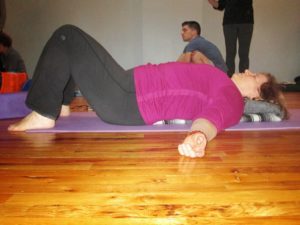
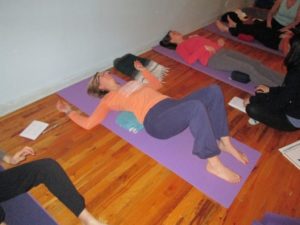
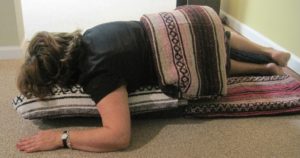
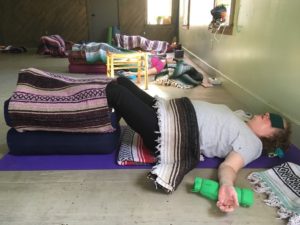
Leave A Comment